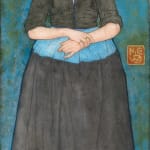Nico Jungmann (1872-1935)
Nico Wilhelm Jungmann was born in Amsterdam to a family with no connections to the arts.[1] At the age of twelve, he was apprenticed to a decorative painter who taught him to paint murals. Recognizing his talent after four years of training, Jungmann was admitted to the Rijksakademie van beeldende kunsten. With a scholarship from Arti & Amicitiae, Jungmann moved to London in 1893, intending to send sketches of London life back to Holland. Instead, he travelled, illustrating travelogues featuring locals and locales. His journeys took him to Holland, Brittany, Normandy, Italy, and Belgium.
From his early years in London, Jungmann successfully showed with prominent galleries such as Dowdeswell, Leicester, and Rembrandt. He debuted at the Royal Academy in 1897 and continued showing there until 1923. He participated in international exhibitions in Munich, Paris, and Brussels. A raving review in The Studio compared Jungmann’s drawings to Holbein’s works at Windsor Castle and Rembrandt’s etchings of Rembrandt: placing him as a promising star in the artworld.
In 1897, Jungmann accompanied the renowned Volendam innkeeper Spaander and his two daughters—dressed in folklore costume— to an international tourism exhibition in London, lending weight to the village’s artistic appeal.[2] Volendam, about twenty kilometers northeast of Amsterdam, remained resolutely resistant to change. At the turn of the century, the picturesque fishing village became an artist destination, attracting Monet, Whistler, Signac, Renoir and the like.
Volendam’s coat of arms—a white foal stepping on a flounder—tells the tale of the town’s legend and the bravery of its women. According to the legend, Lijsje, a fearless farmer’s daughter, was visited by a mystical seahorse delivering a bountiful catch from the sea. Unafraid, Lijsje fed it clover, and one fateful night, she vanished into the waves with her otherworldly companion. In their search for Lijsje, the farmers discovered the sea’s abundant riches and abandoned their fields for boats, transforming Volendam into a prosperous fishing village. Though no fisherman ever won the local heroin’s love, her legacy forever links the village to the sea.
During his travels, Jungmann created detailed drawings, carefully adding his model before applying color. Using self-made crayons, his drawings often echo Japanese woodcuts, highly fashionable at the turn of the century. While traditional costume was vanishing from Dutch cities by the late nineteenth century, Jungmann’s idealizes a frozen life untouched by modernity. Volendam exemplifies Jungmann’s fondness for picturesque Holland and the mythical muse of Volendam.
[1] E.B.S., “Some drawings by Mr. Nico Jungmann”, The Studio 12-14 (February 1898), no. 59, pp. 25-30
[2] Brian Dudley Barrett, North Sea Artists’ Colonies, 1880-1920, doctoral thesis, Groningen 2008, p. 217



